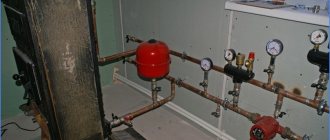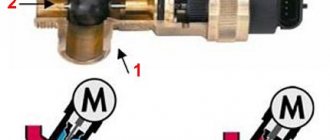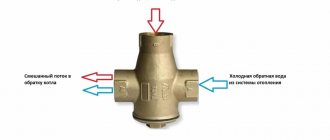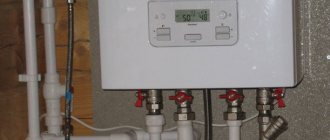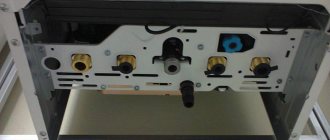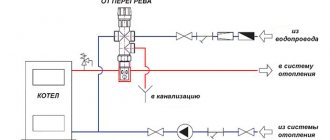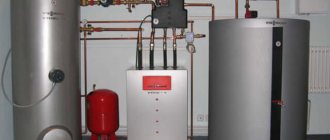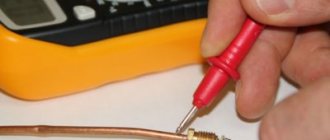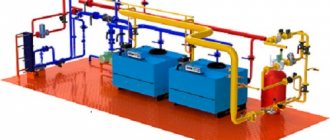The boiler operation is corrected by a safety valve. It is very important to monitor its serviceability. When it starts to drip, many questions arise: why is water dripping from the safety valve of the water heater, how much water is permissible, how to determine its malfunction.
The main function of the device is to discharge excess water that appears when the instantaneous water heater is heated. The safety valve flows to reduce the internal pressure of the boiler. Water droplets appear from the valve. There are several reasons for this, it is necessary to understand them.
The valve is dripping when the boiler is off
The situation is considered when the water heating device is not included in the network, water is supplied from the water supply system. At this time, there is a leak of liquid from the drainage hole of the water heater. Two reasons can lead to this process:
- the safety valve for the water heater is out of order;
- excessive pressure in the pipeline.
To determine the cause, the cold water supply pressure in the system is measured. It is the excess of the pressure indicator, which is established by SNiP, that leads to the discharge of excess water.
The device opens and performs its main function - it reduces the pressure in the tank. The standard pressure, which allows the product to operate without failure, is set by the manufacturers in the range of 6-8 atmospheres. SNiP set the maximum pressure at 6 atmospheres. In the pipeline, it often exceeds the norm by 2 units.
The valve is triggered and discharges excess water into the sewer.
The device has broken: the plate is worn out, the spring has weakened - these are the reasons that lead to the discharge of water. The situation may develop according to another scenario: particles of debris got under the plate.
A broken product cannot simply be thrown away. It is necessary to replace with a new valve, which will help to avoid dangerous accidents. An operating boiler without a safety device can cause an explosion.
Water flows from the safety valve on the water heater - what to do?
I understand that you are only interested in the answer "... why is the water dripping?" and the educational program about technical nuances is not interesting to you. However, I will not deviate from my rule, and I strongly recommend that you always first understand the structure and purpose of the device, and only then find out the cause of its malfunction. Just when you know what it is and why, the answer to the question "... why is water dripping?" will become clearer to you. Plus, you can teach others how to deal with this problem yourself.
And so, let's get started. What is an overpressure relief valve installed on a storage-type heater (boiler)
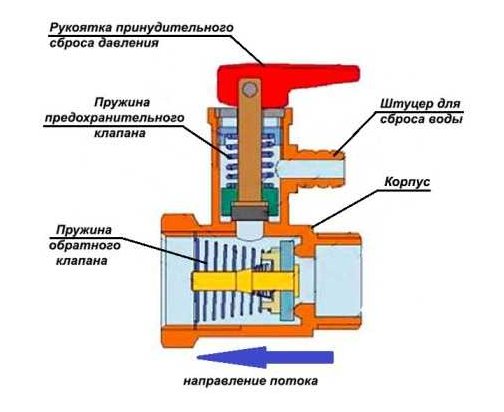
The safety valve consists of two valves in one body.
The first check valve is designed to shut off the flow of water from the boiler back to the supply system when the pressure drops (or is completely absent). So if, when the cold water is turned off, the water from the boiler will flow out (do not be in its path of the check valve), the heating elements will become bare, heat up and burn out. And if they only warmed up and gave water to an empty tank, then a lot of steam and a rupture of the boiler.
The second valve is "unloading" and is precisely the pressure relief valve. It is usually located in the part perpendicular to the main line and has a lever for forced opening of the valve. On it is the very fitting from which water is dripping or flowing. This valve is needed to discharge water that has formed from natural expansion during heating. If this valve is working properly, then it MUST drip.If a water heater heats water from cold to hot temperature several times a day, then with each heating, the pressure inside the tank increases, and each time excess water must be dumped. With one heating, this is about 3% of the total volume of water.
Well, now you figured out what's what, and it's time to find out the reasons for the dripping water. It should be noted when water drips from the union of the registration valve. In a normal state, water should drip in when the water is heated. When the water temperature is close to turning off the heating element, water can run in a thin stream. And this is a normal state, for this this device is needed - to protect your boiler from rupture, and you from injury.
If water runs constantly from the fitting, even when the heating element is off (that is, heating does not occur), this is a signal that the pressure relief valve is faulty.
It is in order to control the volume and time of water discharge that the drain tube put on the fitting must be transparent.
There are also adjustable safety valves. If possible, it is worth trying to adjust the valve by tightening the spring. But it should be borne in mind that most boilers are designed for pressures from 6 to 10 atmospheres, and the steam pressure may be higher, and the seams of the tank and the mating of the heating element seat may not withstand. And the pressure gauge built into the supply pipe between the safety valve and the boiler, I have not seen from anyone. So, in case of constant leakage, I advise you to replace the unloader valve completely, with the factory settings at the time the valve opens.
The valve is dripping when the boiler is on
The situation is simulated when the water heater is on without draw-off.
- The cause of water discharge will be valve breakage.
The explanation is simple: with the initial heating of the liquid, its volume increases by 3%. This surplus is discharged into the sewer. But after that, the heating device simply keeps the water in a constant temperature regime. There should be no dripping from the valve.
Droplets indicate that the device is malfunctioning or clogged with debris.
- The second, considered situation, paints a picture of the correct operation of the mechanism.
The water heater works with increased water intake (take a shower). The volume of hot water goes away, cold liquid enters its place. The new flow begins to heat up - “new” surplus water appears, which is continuously discharged into the sewer system.
- The third situation arises when the water intake is extended over time. The discharge of water does not have to be permanent. It drips from the safety valve periodically. This indicates the correct operation of the device.
For example, dishes are washed. The drawdown process is extended. Also, water should not drip constantly.
Device and principle of operation
Externally, the safety valve for the water heater is two brass cylinders, one of which is attached to the side of the other. The larger cylinder is a poppet valve (aka a check valve for a water heater), it ensures the movement of liquid in one direction and does not allow it to flow in the opposite direction. There are threads on both ends of this piece to connect the valve to the boiler and pipes.
A blasting valve (aka spring-loaded direct action) is located perpendicularly. From the outside, it is muffled, and on the side there is a small pipe for draining water. Inside it is a valve with an opposite actuation stroke.
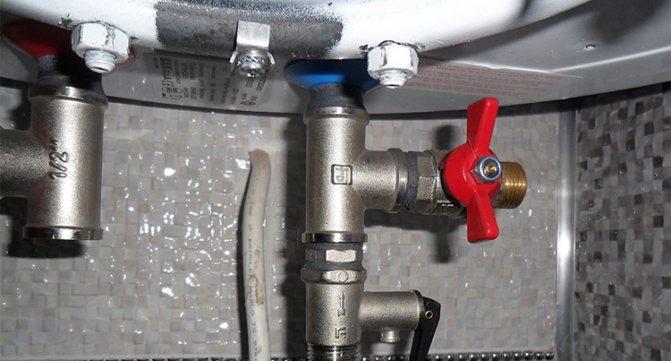

Installed safety valve for boiler
As long as the pressure is normal, the valve is "closed" and does not allow fluid to flow out. This is done by pressing the spring. But when the water pressure exceeds the spring force, it opens and releases excess water. Often there is a handle on the valves for forced water drainage (when the owner needs to empty the water heater).
Did you know that the operation of a gas boiler can be controlled manually or automatically? Automation for gas heating boilers: what are the differences between volatile and non-volatile systems? Functions and varieties of gas valves.
Read about what malfunctions can happen with Navien boilers and how to fix them here.
If your water is heated using a gas water heater, you probably faced such a problem - the gas boiler goes out. Here https://microklimat.pro/otopitelnoe-oborudovanie/kotly/pochemu-tuxnet-gazovyj.html you will learn why this happens and how to troubleshoot.
Reasons for boiler leakage
Most often, excess water is noticed from above or below the water heater. Before looking for a problematic leak, you need to turn off the water supply and disconnect the boiler from the power supply.
Here are 10 types of breakdowns that can cause water leakage.
Poor connection of supply channels


This situation is one of the most common water heater leaks. The supply channels are not tightly connected to each other.
It is necessary to recheck the connections of the inlet and outlet pipes - see if they are loose. It is necessary to tighten the joints with a wrench or replace the faulty pipeline.
Deformation of the case
Appears due to violations during the installation of the water heater. This is not the manufacturer's fault. Most likely, the safety valve is missing or defective. Therefore, the dripping water from the boiler is noticeable immediately after the installation of the water heater.
During cooling, the volume of liquid is reduced and the boiler tank is compressed. When all the liquid is gone, a vacuum begins inside the reservoir. When there is a problem with the safety valve, the container deforms during these processes.
As a result, during the filling of the water heater, the water begins to warm up and expand, increasing the pressure. Due to the growth of the latter, the reservoir tank begins to swell, provoking a leak in the body.
Leaking tank
If the liquid escapes through the piping, then the reservoir tank is leaking.
This problem often appears due to:
- incorrect installation;
- violations during connection;
- generated water hammer
The tank is designed for a certain maximum pressure. Exceeding this pressure can lead to a water hammer, which can subsequently cause a leak.
Tank lid leaking
For most, this flow appears in the heating element. One of the reasons is a large accumulation of scale.
To solve the problem, you need to install a new heating element.
Leaking heating element
Some boilers do not have a dedicated drainage passage. It helps in case of a tubular electric heater (TEN) leakage.
Therefore, when choosing a boiler, it is worth checking its availability.
6. Defective safety valve


Safety valve - a tap that is installed in case the water in the tank gets too hot. Excessive pressure will build up. The valve relieves pressure by releasing some of the water.
First, inspect the point where the valve connects to the tank. Then the crane itself.
If the valve is in the closed position and water flows from the connected water heater pipe, the valve is defective. It needs to be replaced.
When the valve is in the open position, it is capable of relieving excess pressure from inside the reservoir (causing the valve to open). Repair is possible, but it is better to call the master.
Problems with heating elements
There are two situations of leakage from the heating element:
- leakage from under the seal;
- hollow space under the bolts.
In the first paragraph, tighten the nuts that secure the heating element.
In the second, change the tubular electric heater.
Runs in the upper area without external damage
First, you need to check the following conditions:
- no problems were found when studying the elements of the boiler;
- installation / connection of the water heating system was carried out without violations;
- the magnesium rod was checked at least twice a year. If necessary, a new one was installed.
If the boiler still leaks, it is best to return to the store under warranty. The leak is eliminated only when the boiler tank is made of stainless steel.
Important: it is important to replace the magnesium rod with a new one regularly. Otherwise, the surface of the water heater will deteriorate. There will be a need to purchase a new one.
Neglecting prevention
Increased water hardness, a large amount of impurities in it do not have the best effect on the operation of the water heater. Therefore, from time to time it is worth carrying out preventive work: to clean the device from dirt, to replace worn-out parts in time. This way you minimize the occurrence of leaks in the water heater.
10. Defective or incorrect installation and connection
If the device is defective, it must be returned to the store before the end of the warranty period. The main thing in these circumstances is not to try to repair it by your own efforts. Since the water heater will not be accepted in the store.
If the cause of the leak is violations during the installation and connection of the water heater, it is worth re-reading the points above again - check the elements of the boiler. And also re-familiarize yourself with the installation and connection instructions to find out where the mistake was made.
Choice
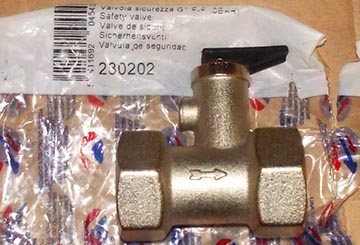

When buying a safety valve for a water heater, you need to pay attention to the following:
- what temperature it is designed for;
- on threaded connections (most often it is ½ inch);
- pressure;
- is there such a useful attribute as a handle for forced draining.
Valve pressure is an indicator that must be clarified when buying! If you buy a device with a smaller size, water will flow from the valve all the time. If with more - it may be useless and not protect from the explosion of the boiler.
